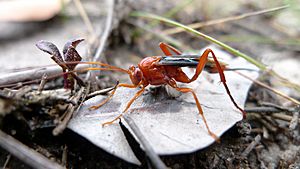Orchid dupe wasp facts for kids
Quick facts for kids Orchid dupe wasp |
|
|---|---|
 |
|
| Scientific classification | |
| Kingdom: | |
| Phylum: | |
| Class: | |
| Order: | |
| Family: |
Ichneumonidae
|
| Genus: |
Lissopimpla
|
| Species: |
L. excelsa
|
| Binomial name | |
| Lissopimpla excelsa (Costa, 1864)
|
|
| Synonyms | |
|
Lissopimpla semipunctata Kirby |
|
The Lissopimpla excelsa, also known as the orchid dupe wasp, is a type of wasp. It belongs to the Ichneumonidae family. This amazing insect is originally from Australia. It can also be found in New Zealand, where it is sometimes called the dusky-winged ichneumonid. Scientists believe it was probably brought to New Zealand by accident.
This special wasp helps pollinate five different types of orchids in Australia. These orchids belong to the genus Cryptostylis. The male wasp tries to mate with the orchid flowers. It mistakes parts of the flower for a female wasp. This unique way of pollination is called "pseudocopulation". It means "fake mating."
Contents
How the Wasp Pollinates Orchids
A Clever Orchid Trick
The Cryptostylis orchids have a very clever trick. Their flowers look very similar to female wasps. This is true when seen through a wasp's eyes. To humans, the flowers and wasps look quite different. But wasps see colors like green, blue, and ultraviolet light. The orchid flowers also release a special smell. This smell attracts the male wasps.
When a male wasp tries to mate with the flower, it helps the orchid. Pollen from the flower sticks to the wasp. The wasp then carries this pollen to another orchid. This helps the orchids make seeds. Even if different orchid types grow together, they do not mix. This means no hybrid orchids are found in nature.
Discovery of Pseudocopulation
This amazing discovery was made in 1928. An Australian naturalist named Edith Coleman found out about it. Since then, scientists have seen this "fake mating" in other orchid types too. It is a fascinating example of how plants and insects interact.
About the Orchid Dupe Wasp
What Does It Look Like?
The orchid dupe wasp has a unique appearance. Its head, middle body part (mesosoma), and legs are reddish-brown. The last few parts of its tail (metasoma) are also reddish-brown. The first four parts of its tail are black. These black parts have two large white spots on each side. Its wings are a dark, smoky brown color. The tips of its front wings are a bit lighter.
A Parasitic Lifestyle
Like other wasps in its family, L. excelsa is a parasitoid. This means it lays its eggs inside or on other insects. The young wasps (larvae) then feed on the host insect. One insect it preys on is a type of moth. This moth is called Helicoverpa armigera. It is known as a pest in farming.
History of the Wasp's Name
The orchid dupe wasp was first described in 1864. An Italian scientist named Achille Costa gave it the name Pimpla excelsa. Later, in 1889, another scientist named Joseph Kriechbaumer placed it in a new group. This new group was called Lissopimpla. He named it Lissopimpla octo-guttata. For many years, it was also known as Lissopimpla semipunctata. However, Costa's original name, Lissopimpla excelsa, is the correct one today.

